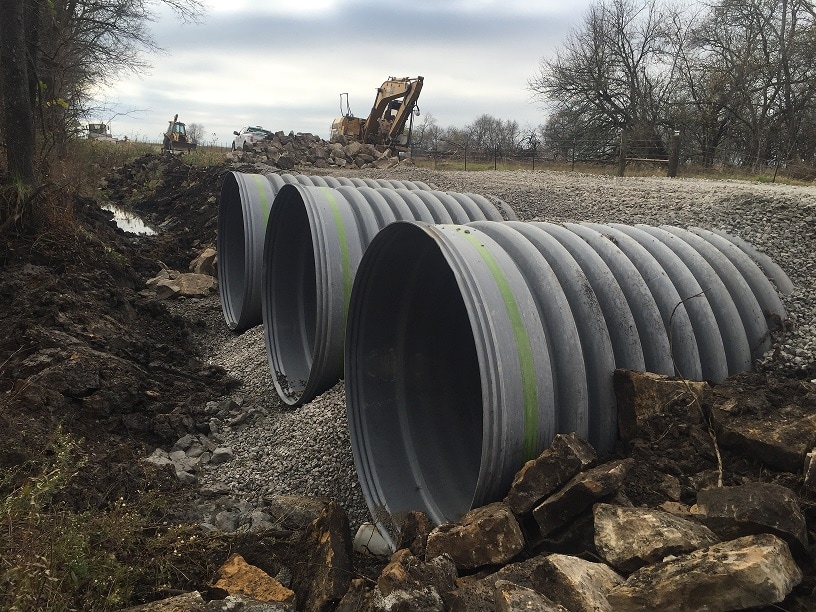Culvert Installation Facilitated: Step-by-Step Guide for Success
From picking the appropriate culvert size to incorporating proper drain measures, each step in the installment process plays a vital function in the capability and longevity of the culvert system. Keep tuned to reveal the vital actions and factors to consider that can make culvert installation a seamless and effective venture.
Selecting the Right Culvert Dimension
Picking the ideal culvert dimension is important for making certain efficient water circulation and architectural stability in culvert setup tasks - Pad Construction. The size of the culvert directly affects the circulation capability of water through the structure. A culvert that is as well tiny can cause flooding and overflow, while one that is also huge might lead to decreased water speed, possibly triggering sediment accumulation and clogs
To determine the ideal culvert size, aspects such as the watershed location, height flow rates, and hydraulic efficiency need to be meticulously considered. Calculations based upon these criteria assist in choosing a dimension that can sufficiently take care of the anticipated water volume while decreasing the risk of obstructions and architectural failing.
It is vital to speak with design guidelines and standards to guarantee that the chosen culvert size satisfies the task demands and local laws (Pad Construction). By choosing the right culvert dimension, task supervisors can optimize water circulation, avoid possible problems, and enhance the total efficiency and long life of the culvert setup
Preparing the Installation Site
Effective culvert installation requires careful prep work of the installation website to make certain optimum structural support and capability. Before commencing the installation procedure, it is vital to get rid of the website of any kind of particles, greenery, or blockages that can impede the culvert's placement. Making sure a degree foundation is crucial for the proper positioning and security of the culvert. This might include grading the site to create a smooth, also surface that can properly sustain the weight of the culvert and any kind of anticipated tons. In addition, proper compaction of the dirt below the culvert is essential to protect against clearing up or changing in time.
Furthermore, it is vital to take into consideration factors such as dirt structure, groundwater degrees, and environmental effects when preparing the installation site. Performing an extensive site analysis can assist identify any kind of prospective obstacles or threats that may affect the culvert's performance. By making the effort to prepare the installation website appropriately, you can assist ensure an effective culvert installation basics that satisfies architectural needs and ensures long-lasting performance.
Placing the Culvert Properly

The grade at which the culvert is placed is critical for preserving a correct slope for water flow. Furthermore, the culvert needs to be oriented properly to make certain that the inlet and outlet are in the correct places. Pad Construction.
Backfilling and Condensing the Dirt
Proper backfilling and compaction of the dirt around the culvert is vital to make certain stability and avoid potential concerns in the future. Once the culvert is correctly put, the next important action is to backfill the area around it with appropriate product. The backfill material should be devoid of rocks, debris, and raw material to avoid damage to the culvert. It is advised to make use of granular product such as sand or gravel for backfilling, as it gives excellent drain and compaction residential or commercial properties.
Compaction see this here assists in decreasing the chances of negotiation and makes certain uniform support around the culvert. It is essential to portable the dirt uniformly on all sides of the culvert to preserve its architectural honesty.
Proper backfilling and compaction not just give security to the culvert but also assist in avoiding dirt erosion and keeping the durability of the culvert system.
Making Certain Appropriate Drain Assimilation
Integrating efficient drain services plays an essential duty in the total functionality and durability of culvert setups. Correct drainage combination is important for managing water circulation, stopping disintegration, and guaranteeing the architectural stability of the culvert system. To accomplish this, it is essential to design a comprehensive drainage strategy that thinks about factors such as the quantity of water anticipated, the topography of the area, and the sort of dirt present.

Furthermore, incorporating attributes like disintegration control procedures, such as riprap or plants, can even more improve the effectiveness of the water drainage system. By carefully preparing and executing these water drainage services, culvert installments can operate successfully and endure the examination of time.
Conclusion
Finally, proper culvert installment is critical for maintaining efficient drain systems. By picking the best culvert dimension, preparing the installation site, positioning the culvert correctly, backfilling and condensing the dirt, and ensuring correct drainage combination, success can be accomplished. Following these actions will assist guarantee the long life and efficiency of the culvert, eventually adding to the general success of the drainage system.
 Michael Oliver Then & Now!
Michael Oliver Then & Now! Val Kilmer Then & Now!
Val Kilmer Then & Now! Michael C. Maronna Then & Now!
Michael C. Maronna Then & Now! Macaulay Culkin Then & Now!
Macaulay Culkin Then & Now! Erika Eleniak Then & Now!
Erika Eleniak Then & Now!